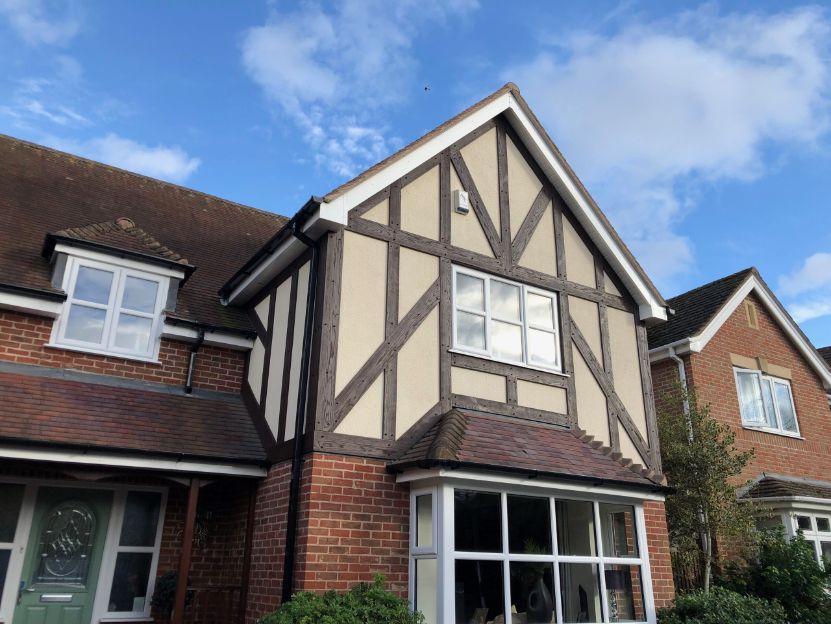A Guide to Tudor-Inspired Exterior Home Design

As you approach any home, there are a range of features that, no matter how subtle or sparingly used they are, will always make a house stand out as a Tudor-inspired house. Tudor boards, decorative timbers, steep roofs, and beams all invite you into a modern house that takes inspiration from the past, so embrace this distinctive exterior home design that has captivated homeowners for centuries with our guide.
Tudor-Inspired Exterior Home Design
Nestled in the heart of British architectural history, Tudor designs echo an era of functional charm and stylish grandeur that continues to appeal to modern-day tastes. Unlike other similar styles that standout as outdated or too niche, Tudor styles transform any home into a subtle yet impactful statement. So, if you’re looking to add small features, or planning a large-scale redecorating project, join us as we explore the key elements of Tudor exterior home design and offer inspiration to transform your home.
1. Steep Roof
The characteristic high, sharp rooflines of these homes, also known as pitched gable roofs, are a defining feature of any Tudor house. Marked by their high, sharp inclines that create a dramatic silhouette against the sky, these roofs continue to stand out in any residential road by enhancing the visual interest of the homes’ structure. The prominence of these roofs contributes to a home’s unique appearance, and these roofs often feature intricate gables and decorative timbering that reinforces the historic and regal ambience of the design.
Multiple gables that intersect at various angles, and are visible across different elevations of the home, are also distinctive features, creating a dynamic and varied roofline across the entire home. Yet these roofs are not just aesthetic elements; their practical design allows for the quick drainage of rain, hail, and snow, which was crucial in historical England where this style originated, and continues to be a useful design feature to this day.
2. Decorative Half-Timbering
Possibly the most quintessential design feature of this style is decorative half-timbering. These features are characterised by exposed wooden frames that mirror a home’s structural beams, and whilst modern day homes no longer rely upon beams for structural integrity, the style continues to endure.
The spaces between the exposed wooden framing are filled in with plaster, brick, or stone, and this striking technique creates a distinctive patterned effect that is synonymous with the Tudor design that they replicate. The contrast between the rugged wooden beams and the smooth infill panels adds rustic depth and texture to the facade, and half-timbering continues to be popular for its ability to bring a historical, craftsman-like quality to new buildings.
3. Brick Exterior Walls
Whether you choose to opt for decorative timber boards or not, textured surfaces are a simple yet effective way to add depth and character to your homes’ exterior without committing to multiple large-scale installations.
Stucco, also known as render, and more simplistic brick exterior walls provide textured surfaces that add depth and character to a home’s facade in different ways. Stucco is rough, coarse, and applied in a thick layer, and is best used when combined with multiple other Tudor features; whereas brickwork can be used alone as a standout design choice. Both of these designs offer a robust, durable finish that complements the wooden timbers, and continue to be popular ways for homeowners to consolidate their homes’ distinctive image, whilst meeting contemporary construction and energy-efficiency standards.
4. Entryways
Entryways into Tudor-inspired houses are often distinguished by their arched doors, which serve as focal points within the home’s exterior and create a sense of grandeur when approaching. The solid, imposing doors are typically made from heavy wooden materials and are embellished with ornate iron features to add a touch of artisanal craftsmanship, offering a nod to historical elegance whilst providing modern homes with the robust security measures that they require.
5. Windows
When researching Tudor exterior home design, you will most likely see tall, narrow windows with a leaded lattice effect, which is a striking feature for any home and a particularly unique feature for Tudor houses. These windows are divided up into diamond-shaped cross-section panes that are then held in place with leaded bars for unique windows that are very rarely seen in modern-day homes but enhance the house and compliment similar features such as the steep roofs and decorative timbering.
Designing Your Own Tudor House
These elements combine to give Tudor-style homes their distinctive, historic appearance that celebrates the architectural spirit of Tudor England.
So, if you’re looking to embrace the rich heritage of Tudor architecture this spring, trust Tudor Boards Ltd to be your partner in bringing this timeless exterior home design to life. Whether you are renovating your house, or building the project of your dreams, their range of cladding, planks, and panels are here to infuse your home with historical style and modern reliability that you can depend on for years to come, so explore their full range today.